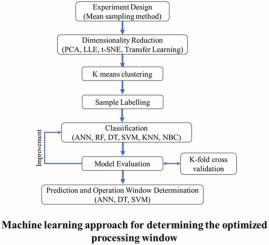Journal of Materials Processing Technology ( IF 6.3 ) Pub Date : 2022-07-05 , DOI: 10.1016/j.jmatprotec.2022.117716 Bing Wang , Peng Wang , Jie Song , Yee Cheong Lam , Haiying Song , Yang Wang , Shibing Liu

|
Surface nanostructuring could enhance surface properties such as strength, self-cleaning, anti-fog and anti-bacterial properties. Femtosecond laser-induced periodic surface structures (LIPSS) is a nanoscale structure created with laser technique. However, its quality is significantly influenced by the complicated interrelationship between the various laser processing and material parameters. Hitherto the selection of the appropriate laser parameters mainly depends on personal experience in conjunction with many time-consuming experimental trials. To have a simple, fast, and intelligent process, a hybrid machine learning method is proposed to determine the optimized processing window for femtosecond laser-induced nanostructures. Firstly, k-means clustering method was applied to automatically classify the laser-induced nanostructures into good and bad quality classes. Before clustering, dimensionality reduction methods were applied to reduce the high dimension of image data and to extract features. Different dimensionality reduction methods including principal component analysis (PCA), local linear embedding (LLE), t-random adjacent embedding (t-SNE) and transfer learning were explored. Transfer learning showed a much better result compared with other dimensionality reduction methods. Transfer learning VGG19 model achieved the highest accuracy of 90.6 %. After clustering, the image was labelled as good and bad clusters accordingly. The labeled image was trained using artificial neural network (ANN), random forest (RF), decision tree (DT), support vector machine (SVM), k-nearest neighbors (KNN) and Naive Bayesian Classifier (NBC) algorithms for the prediction of laser processing results. The results show that DT gives the best accuracy of 96.7 %. Finally, an optimal laser processing window for femtosecond laser-induced nanostructures was determined.
中文翻译:

一种混合机器学习方法来确定飞秒激光诱导的周期性纳米结构中的最佳加工窗口
表面纳米结构可以增强表面性能,例如强度、自清洁、防雾和抗菌性能。飞秒激光诱导的周期性表面结构(LIPSS)是一种利用激光技术创建的纳米级结构。然而,其质量受到各种激光加工和材料参数之间复杂的相互关系的显着影响。迄今为止,选择合适的激光参数主要取决于个人经验以及许多耗时的实验试验。为了实现简单、快速和智能的工艺,提出了一种混合机器学习方法来确定飞秒激光诱导纳米结构的优化加工窗口。首先,应用k-means聚类方法将激光诱导的纳米结构自动分类为质量好和质量差的类别。在聚类之前,应用降维方法来降低图像数据的高维并提取特征。探索了不同的降维方法,包括主成分分析(PCA)、局部线性嵌入(LLE)、t-随机相邻嵌入(t-SNE)和迁移学习。与其他降维方法相比,迁移学习显示出更好的结果。迁移学习 VGG19 模型达到了 90.6% 的最高准确率。聚类后,图像被相应地标记为好聚类和坏聚类。使用人工神经网络 (ANN)、随机森林 (RF)、决策树 (DT)、支持向量机 (SVM)、用于预测激光加工结果的 k 近邻 (KNN) 和朴素贝叶斯分类器 (NBC) 算法。结果表明,DT 的最佳准确度为 96.7 %。最后,确定了飞秒激光诱导纳米结构的最佳激光加工窗口。



























 京公网安备 11010802027423号
京公网安备 11010802027423号